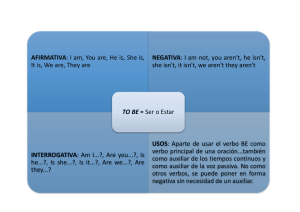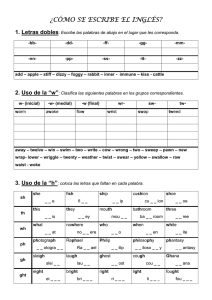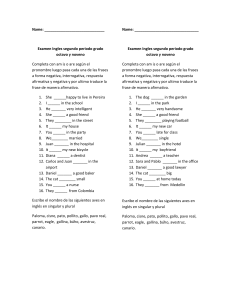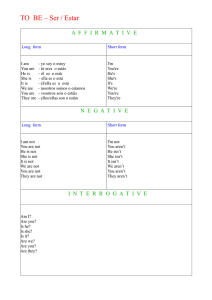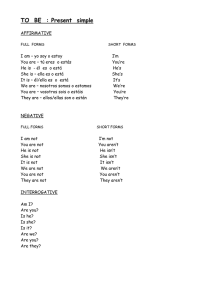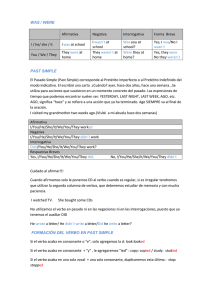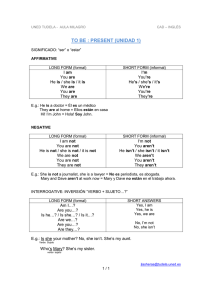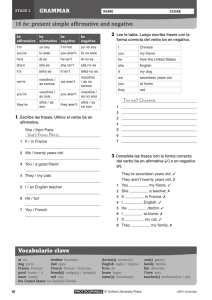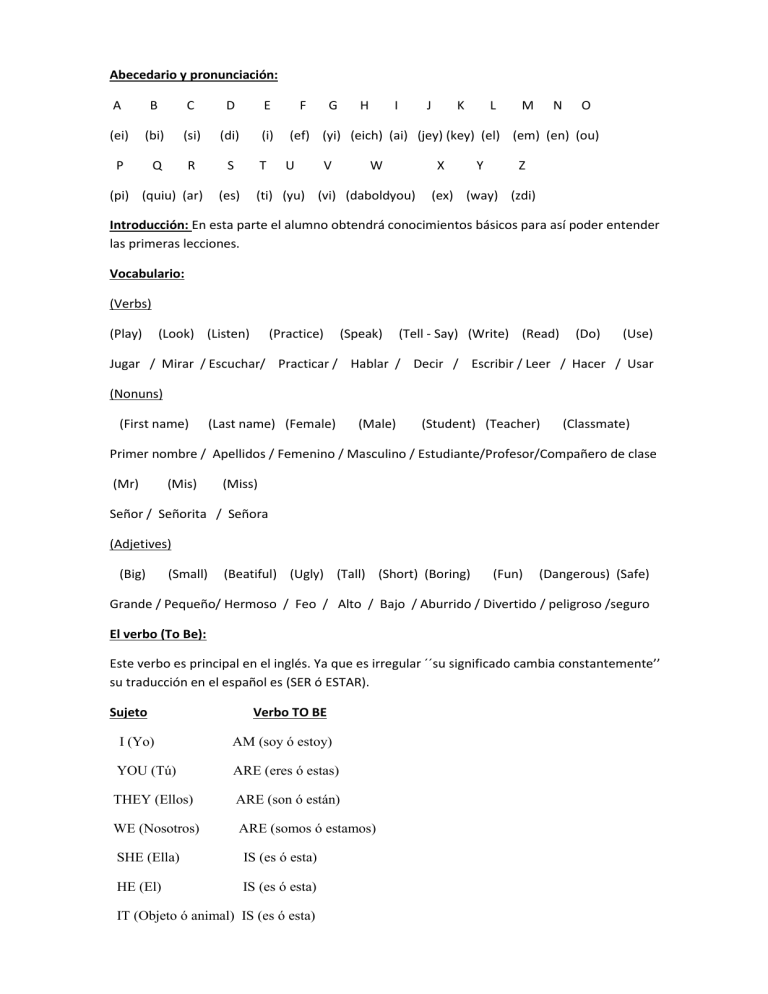
Abecedario y pronunciación: A B C D E (ei) (bi) (si) (di) (i) (ef) (yi) (eich) (ai) (jey) (key) (el) (em) (en) (ou) P Q R S T U (pi) (quiu) (ar) (es) F G H V I J W K X (ti) (yu) (vi) (daboldyou) L Y M N O Z (ex) (way) (zdi) Introducción: En esta parte el alumno obtendrá conocimientos básicos para así poder entender las primeras lecciones. Vocabulario: (Verbs) (Play) (Look) (Listen) (Practice) (Speak) (Tell - Say) (Write) (Read) (Do) (Use) Jugar / Mirar / Escuchar/ Practicar / Hablar / Decir / Escribir / Leer / Hacer / Usar (Nonuns) (First name) (Last name) (Female) (Male) (Student) (Teacher) (Classmate) Primer nombre / Apellidos / Femenino / Masculino / Estudiante/Profesor/Compañero de clase (Mr) (Mis) (Miss) Señor / Señorita / Señora (Adjetives) (Big) (Small) (Beatiful) (Ugly) (Tall) (Short) (Boring) (Fun) (Dangerous) (Safe) Grande / Pequeño/ Hermoso / Feo / Alto / Bajo / Aburrido / Divertido / peligroso /seguro El verbo (To Be): Este verbo es principal en el inglés. Ya que es irregular ´´su significado cambia constantemente’’ su traducción en el español es (SER ó ESTAR). Sujeto Verbo TO BE I (Yo) AM (soy ó estoy) YOU (Tú) ARE (eres ó estas) THEY (Ellos) ARE (son ó están) WE (Nosotros) ARE (somos ó estamos) SHE (Ella) IS (es ó esta) HE (El) IS (es ó esta) IT (Objeto ó animal) IS (es ó esta) Ejemplos: Ser I Am Estar a student. I You Are a teacher. You Are in the car. They Are classmates. We Are She Is He Is It Is Friends. beatiful. Am at the school. They Are talking together. We Are watching TV. She Is at home. a soccer player. He Is playing. a book. It Is my dog. Crear preguntas de si ó no: El hecho consiste en intercambiar la posición de verbo TO BE posicionándolo delante ó detrás del sujeto. De hecho es muy parecido al castellano, al afirmar y preguntar por ejemplo cuando afirmas un hecho como: EL ES ALTO ó cuando preguntas ¿ES EL ALTO? Intercambias el verbo “ES” delante del sujeto para afirmar algo o decir un hecho. Todo es igual en el castellano al posicionar el verbo TO BE delante del sujeto estas afirmando algo y al poner el verbo TO BE detrás del sujeto Este cambia su sentido al de pregunta. Ejemplos: - He is playing soccer. - Maria is talking to Juan. - Is - he playing soccer? Is Maria talking to Juan? - You are Juan, Right. - She is using her cellphone in class? - Excuse me, Are you Juan? - Is she using her cellphone in class? - It is safe. - She is listening to music. - Is it safe? - Is she listening to music? Respondiendo preguntas: En esta sección el alumno aprenderá a responder preguntas simples Ejemplos: Contractions Are you Verónica? - Yes I am/ No I am not - (No I’m not) Is she paying atention to the class? - Yes she is/ No she is not - (No she isn’t / No she’s not) Is he an actor? - Yes he is/ No he is not -(No he isn’t / No he’s not) Is that your pet? - Yes it is/ No it is not -(No it isn’t / No it’s not) Am i in this class? – Yes you are/No you are not -(No you aren’t / No you’re not) Are they live there? - Yes they are/ No they are not -(No they aren’t / No they’re not) Are we on your house? Yes we are/ No we are not -(No we aren’t / No we’re not) Practicar Conversación: Pedro: Hi, my name is Pedro. What’s your name? Alberto: Hi, Pedro I´m Alberto, but please call me Beto. It’s my nickname. Pedro: Okay, Beto. Nice to meet you. Alberto: It’s nice to meet you too. Expresiones comunes para presentarse Useful expressions(introducing yourself) Hi, What’s your name? Hi, my name is Pedro. Hi, I’m Pedro. It’s Pedro. My name is Mr. Araujo. I´m Ms. Whitman (It’s) nice to meet you. (It’s) nice to meet you, too. Preguntas con Where, Who, What (Wh Questions): Where: refiere a un lugar ¨Donde¨ Who: refiere a una persona o a alguien ¨Quien¨ What: usualmente usado al principio de una pregunta ¨Cual o Que¨ *El verbo TO BE siempre debe estar detrás del sujeto ya que estamos formulando preguntas. Ejemplos: Where are you? - Where is she from? Who are you? - Who is talking to me? - Where is he living? - Where are you going? -Who is going to the party? - Who are they? What is your name? - What is his cellphone number? What are they doing? – What are we talking about? *El verbo TO BE siempre tiene que estar después del sujeto ya que respondemos usualmente afirmando hechos. Respuestas: I’m from Huancayo, Perú. - She’s from Seoul, South Korea. - He’s living on 2demayo and Real Street. - I’m going to buy a watch. - She’s talking to you. – They are my cousins Useful expressions Asking Where someone is from Practicar conversación (Wh Questions): -Where are you from? Gabriela: Excuse me? Are you in this class? (I’m from) Korea Ana: Yes, I am. -Are you from Colombia? Gabriela: Who´s the teacher? Yes (I am) / No(I’m not) /I’m from Peru Ana: It’s Mr. Allen -Really? / Where exactly? Gabriela: Oh…Hi, I’m Gabriela. Ana: Hi, Gabriela. I´m Ana. -Which city? / Whereabouts in Korea Gabriela: Your shirt is cool. Are you from Colombia? (I’m from) Huancayo /Lima/Ica. Ana: Yeah. Gabriela: Where in Colombia? Ana: Bogota. And you? Where are you from, Gabriela? Gabriela: Korea Ana: Oh? Which city? Gabriela: Seoul. Plurals: This/ That / These/ Those: Usa This o These para cosas que están cerca de ti. Usa That o Those para cosas que están lejos de ti. *Usa This o That para referirte a algo en singular y usa These o Those para referirte a algo en plural. Ejemplos: -This umbrella is beautiful. - That phone is expensive. -These umbrellas are beautiful - Those phones are expensive. Singular nouns: Plural nouns: What is this called in English? -What are these called in English? *para convertir el What is that? - What are those? Sustantivo en plural It’s an MP3 player. – They’re MP3 players. Se adhiere al final It’s an ID card. – They’re ID cards. La S, ES y si termina It’s a –They’re phones. En Y se pone IES phone. It’s a dictionary. –They‘re dictionaries. It’s a key. – They’re Keys. It’s a watch. – They’re watches. It’s a dish. – They’re dishes. *a o an es singular referente a uno o una / usualmente se pone an cuando la primera letra de la siguiente palabra se pronuncia con una vocal y a cuando la primera letra de la siguiente palabra se pronuncia con una letra. Vocabulario: Verbs: (Like) (Eat) (Cook) (Have) (Need) (Sing) (Dance) (Jump) (Study) (Work) (Teach) (Go) Gusta /Come /Cocina /Tiene /Necesita /Canta /Baila /Salta /Estudia /Trabaja / Enseña / Ir Nouns: (Actor) (Actress) (Kid) (Park) (Husband) (Wife) (Brother) (Daughter) (Uncle) (Aunt) Actor /Actriz / Niño / Parque / Esposo / Esposa /Hermano / Hermana / Tío / Tía Adjetives: (Cheap) (Expensive) Barato / Caro (Happy) (Sad) / Feliz (Hungry) (Handsome) (Dirty) (Ugly) (Old) / Triste / hambre / bello / Sucio / Feo / Viejo Lección # 1: -Simple present (presente simple) Usa el ¨simple present¨ para expresar la idea de que una acción es repetida o usual. La acción puede ser un habito, un hobby, un evento diario o algo que sucede con frecuencia. También puede ser algo que una persona a menudo se olvida o no suele hacer. *En el inglés como en el español el verbo cambia según se va conjugando con el sujeto Ejemplos: Subject / verb /rest of the sentence I - play tennis. *La forma básica del verbo no cambia cuando se We - play tennis. refiere a I(yo) We(nosotros)They(ellos) They - play tennis. en cambio cuando se refiere a She(ella) He(el) She - plays tennis. o It(cosa o animal) el verbo suele cambiar He - plays tennis. aumentando una ¨S¨ al final del verbo. It - plays tennis. Más ejemplos: She likes cats. -He studies hard. –It looks good. I like cats. - They study hard. – We look good. She needs help. – He goes to the party. –She has two brothers. I need help. – They go to the party. – I have two brothers. Como crear oraciones negativas en simple present: Se usa para expresar cosas que una persona suele olvidar o no hacer o reafirmar cosas que no son ciertas. En estas oraciones se usa el verbo auxiliar ¨Do o Does¨ en su forma negativa ¨Do not (Don’t) o Does not (Doesn’t). Ejemplo: Subject Verb Noun I You We They Sujeto Verb Noun He like don’t like likes Indian food It doesn’t like She *Usa Do o don’t para I, YOU, WE, THEY y usa Does o doesn’t para HE, SHE, IT. Indian food
